Set It & Forget It: 3 Automatic Fish Feeders That Won’t Starve Your Fish
When you purchase through links on our site, we may earn a commission. Here’s how it works.
After spending over 40 hours filling, testing, and tweaking automatic fish feeders, we have found the best fish feeders for precise feeding, reliability and keeping your fish food dry.
The 40-Hour Fish Feeder Showdown (And Why Most Failed)
Automatic fish feeders are supposed to make life easier. You set them up, walk away, and your fish get perfectly timed meals. However, when we put 13 models to the test, reality turned out to be quite different.
Table of Contents
Some feeders jammed within days. Others overfed to the point that filters clogged, water turned murky, and fish went on an unexpected fast afterward.
Even the high-end models weren’t immune to failure when humidity or poor programming came into play.
To separate the reliable from the risky, we tested every feeder under the same conditions. Each was filled with common fish foods — flakes, pellets, wafers, and freeze-dried bloodworms — and monitored for portion consistency, food freshness, ease of setup, and moisture control.

Here’s what we learned:
- Portion control matters. Feeders that relied on rotating barrels often dispensed uneven amounts, especially when the container was full.
- Moisture ruins everything. Tanks with heavy evaporation or surface agitation caused food to clump, jam, or rot inside the dispenser.
- Battery life varies wildly. Some feeders held a charge for weeks; others quit halfway through a seven-day test.
- Smart features aren’t always smart. Wi-Fi and app-connected feeders offered convenience, but only a few actually delivered reliability.
What We Looked For
- Consistent portioning
- Resistance to moisture buildup
- Multiple feeding schedules
- Durability and ease of setup
- Backup power or fail-safe design
By the end of testing, three feeders demonstrated that they could maintain fish health without human intervention.
Best All-Around: Eheim Everyday Fish Feeder Review
The Eheim Everyday Fish Feeder earned our top spot for a reason. It’s reliable, affordable, and consistent — everything you want in a device you’re trusting with your fish’s daily meals.
During testing, the Eheim dispensed a steady amount of food every time. It handled flakes, pellets, and small freeze-dried pieces without jamming or clumping.
The adjustable opening on the rotating barrel makes portioning easy to fine-tune, and the digital timer allows you to schedule up to four feedings per day. It also includes a clamp for rim mounting or can rest on a tank lid.
The simple interface makes setup fast, and replacement parts are widely available, which adds to its long-term value.
Why It Stood Out
- Consistent food portions once calibrated
- Excellent moisture resistance compared to similar designs
- Simple, durable, and quiet operation
- Suitable for most freshwater and saltwater tanks
Want to know more? Read the full review here.
Pro Tip: Replace the batteries before any long trip to prevent interruptions in feeding.
Best For Precision Feeding: Fish Mate F14 Review
If you want total control over every meal, the Fish Mate F14 delivers. Instead of a rotating barrel, it uses 14 individual trays, each loaded with a precise amount of food. When feeding time arrives, a single tray releases into the water.
This design is ideal for community tanks featuring a mix of species. You can combine different foods — flakes for tetras, wafers for shrimp — and dispense them together. You can also leave certain trays empty to create alternating feeding days.
Accuracy aside, the F14 has a clever feature that sets it apart: an airline attachment. By connecting it to your air pump, you can circulate dry air through the feeder, keeping moisture out and food crisp.
What We Liked
- Perfectly measured meals for each feeding
- Compatible with multiple food types
- Works well for tanks with varied diets
- Option to skip days or alternate feedings
What To Consider
- Smaller capacity limits how long it can run unattended
- More time-consuming to refill since each tray must be loaded individually
This feeder is ideal for smaller tanks or aquarists who want precise control over portion sizes. It’s less of a “set it and forget it” model and more of a tool for hobbyists who care about feeding accuracy above all else.
Best Smart Feeder: Hygger Wi-Fi Intelligent Feeder Review
For aquarists who want full control from anywhere, the Hygger Wi-Fi Intelligent Feeder combines modern tech with dependable performance. It connects to an app that allows you to schedule feedings, track your fish’s history, and even watch them eat through a built-in camera.
Beyond the novelty, Hygger’s engineering holds up. The moisture-sealed lid keeps food fresh, and the dual power setup (USB or power bank) ensures feeding continues even during outages. Two interchangeable outlets handle both small and large food types, making it versatile for different species.
Key Features
- App-based remote control and monitoring
- Moisture-proof design to prevent clogs
- Dual power for uninterrupted feeding
- Adjustable dispensing openings for varied food sizes
The Hygger is the best choice for fish owners who travel often or simply like the peace of mind that comes from checking their tank remotely.
Feeders That Failed (And How They Messed Up)
Not every fish feeder earned a gold star. In fact, most didn’t even make it through testing without drama.
Some jammed on day two. Others dumped half a container of food like confetti at a parade. A few just didn’t seem to understand the assignment.
Below are the most memorable failures — ranked not by brand reputation, but by how spectacularly they disappointed.
The Penn-Plax Daily Double
If you enjoy suspense, you’ll love this one. The Penn-Plax Daily Double feeds every 12 hours, like clockwork, but there’s no way to test it until 12 hours later.
You set it up, hope for the best, and wait. That’s not ideal when your fish’s life depends on it.
Build quality was also an issue. The plastic tabs felt brittle, and the cap barely stayed on. While it’s inexpensive, a few extra dollars gets you something far more dependable.
Verdict: Cheap, but unreliable. Feeds on a strict schedule you can’t adjust or verify.
Hydor Automatic Feeder
The Hydor Automatic Fish Feeder wins the award for “most likely to wake you up at 2 a.m.” It’s loud — so loud you’ll hear it from another room. The feeder shakes food loose with every rotation, but the rattling sound is enough to startle both you and your fish.
There’s no digital display, no precise scheduling, and no volume control. Just a noisy motor and unpredictable food drops.
Verdict: Works, technically, but only if you enjoy jump scares.
Zoo Med BettaMatic
The Zoo Med BettaMatic was the only feeder explicitly designed for small betta pellets, which sounded promising. Unfortunately, the scoop-like dispenser consistently dumped far too much food. For a single betta, it’s the equivalent of an all-you-can-eat buffet every time.
The clips that hold the unit together are fragile, and it feels as though one wrong touch could cause them to snap.
While the idea of a compact betta feeder is smart, the execution missed the mark completely.
Verdict: Designed for bettas, but likely to overfeed or break before you need it.
Eheim Twin Automatic Feeder
This one hurts because Eheim usually gets it right. The Twin Feeder appears impressive, offering two separate food compartments for alternating feed types. In theory, it’s brilliant. In practice, it’s just bulky and temperamental.
Flakes tended to clog inside the dispenser, and the large size made it awkward to position.
For the cost, you could buy two of the smaller Eheim Everyday Feeders and get better consistency.
Verdict: Overengineered and overpriced. Good idea, poor execution.
The DoPhin AF013
This model goes by several names, including Nicrew and Goobat, but all versions share the same fatal flaw: inconsistency. It tries to imitate the Eheim Everyday Feeder but lacks precision.
Programming was frustrating, and the portions varied wildly depending on how full the barrel was. Even worse, the build quality felt flimsy. It’s basically a budget knockoff that costs almost the same as the real thing.
Verdict: Tries to copy the best but ends up proving why quality matters.
Imagitarium Automatic Feeder
Sold at many pet stores, the Imagitarium Feeder is easy to find, but that’s its only advantage.
It struggled with portion control, moisture resistance, and consistency. Every test ended with either overfeeding or no output at all.
Even at a midrange price point, performance was closer to bargain-bin quality.
Verdict: Skip it. You can do better at the same price.
Set It, Forget It… But Actually Test It First
An automatic fish feeder isn’t truly automatic until you know it works. Setting one up and walking away without testing it is how you end up with cloudy water, starving fish, or a tank full of floating pellets.
Before you trust any device with your fish’s next two weeks of meals, give it a real-world trial run. It’s the single best way to make sure you’re coming home to happy, well-fed fish instead of a watery disaster.
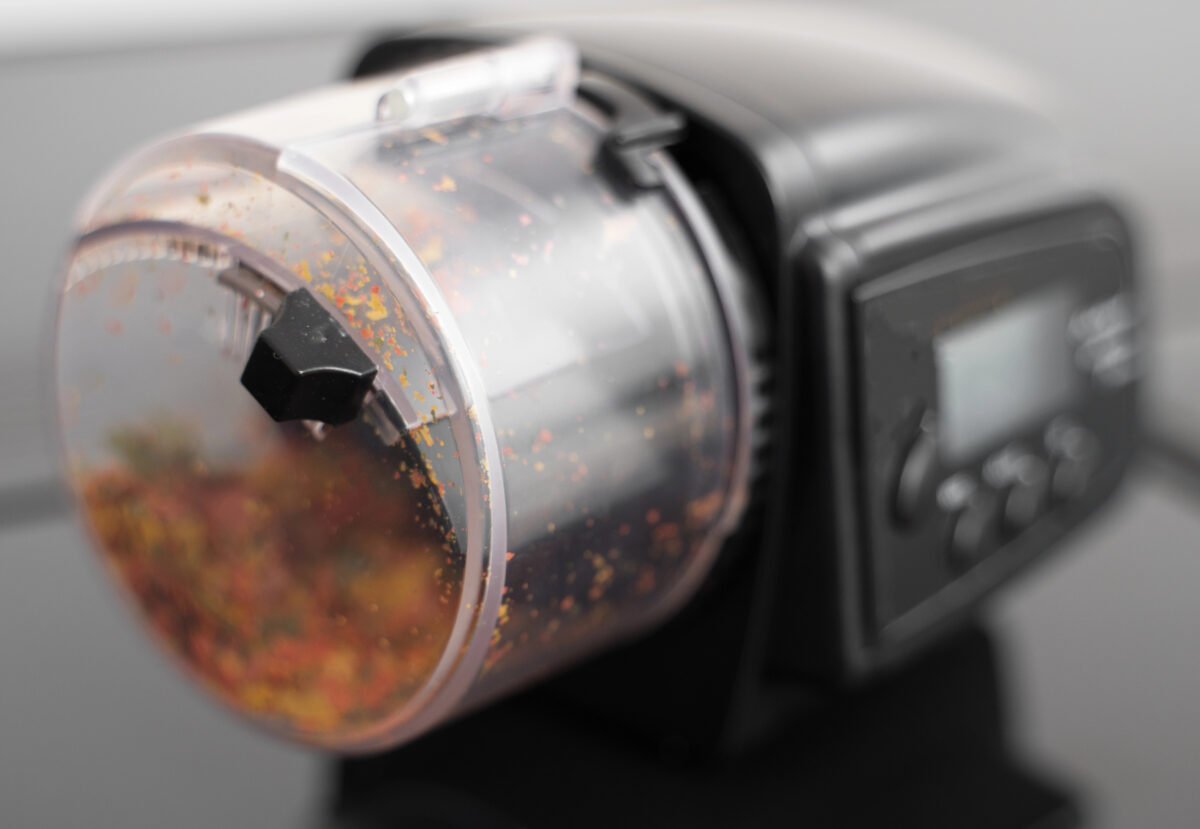
Why Testing Matters
Automatic feeders can behave differently once mounted on your tank. Evaporation, filters, and even air stones can cause subtle changes that affect how the food drops. A perfectly calibrated feeder on your counter may clog, jam, or overfeed once it’s installed.
Moisture is often the hidden culprit. If your feeder sits over moving water or near the filter outlet, condensation can sneak inside, clumping food into a soggy mess. When that happens, the device may rotate but dispense nothing.
Running a test before you travel helps uncover these problems while you’re still home to fix them.
How To Run A Test Feed
Give your feeder a full rehearsal — treat it like you’re already on vacation.
- Set the timer and portion size exactly as you plan to use it.
- Observe multiple feedings over several days to ensure portions are consistent.
- Watch for moisture buildup or clumping inside the food container.
- Check battery life or power connection stability.
- Note food levels to confirm it won’t run out before you return.
A complete test should last as long as your planned time away. If you’ll be gone two weeks, let the feeder run for 14 days before you leave.
The Vacation Checklist
- Test your feeder for the same duration you’ll be gone.
- Monitor food portions for accuracy.
- Replace batteries before leaving.
- Keep the dispenser away from moisture and surface agitation.
- Confirm there’s enough food to last the entire trip.
Find The Right Spot
Location can make or break performance. Too close to your filter outlet, and the food gets blasted across the tank before fish can eat it. Too close to the overflow, and half of it disappears into the sump.

Position your feeder where the surface is calm but still accessible to fish. Avoid placing it directly above an airstone or any area with bubbles that might splash moisture upward.
If you feed floating food, consider using a feeding ring to keep pellets or flakes contained. This simple addition prevents waste and keeps portions consistent.
Pro Tip: If your tank has a lid, use the mounting clamp or cut a small notch for the dispenser opening. That single adjustment can dramatically reduce moisture inside the feeder.
Secure Everything
Even the best fish feeder becomes useless if it falls into the water. Pets, kids, and even clumsy cleaning sessions can knock it loose.
Use the provided clamp or an adhesive mount to keep it stable. If you’re placing the feeder on a tank lid, heavy-duty Velcro works surprisingly well. Just ensure it’s positioned securely and won’t shift over time.
Once the feeder is fixed in place, test it again. Small changes in angle or distance can affect how much food actually lands in the water.
A Final Safety Step
Even when everything looks perfect, swap in fresh batteries before any extended use. Weak batteries are one of the most common causes of feeder failure.
If your model has a backup power port, consider plugging it into a small power bank before you leave.
You don’t need to hover over your tank with worry, but a quick, thorough test ensures your feeder will perform exactly as promised. A few extra days of preparation can save you from a costly reminder that “automatic” doesn’t always mean foolproof.
The Two Types Of Automatic Fish Feeders (And Which One You Need)
Not all fish feeders are built the same. There are only two major types, and choosing the wrong one for your tank could mean clogs, overfeeding, or a hangry school of fish.
Here’s how to tell the difference, and which feeder works best for your tank setup, feeding style, and fish food.
Type 1: Rotating Barrel Feeders
Best for: Extended travel, single food types, minimal fuss
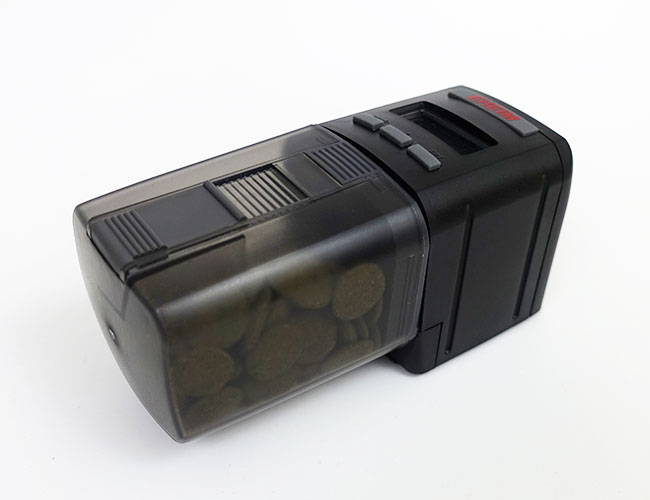
This is the most common style you’ll see online and in pet stores. The design is simple: a barrel holds dried food and rotates at set times, dropping a portion into the tank. You can usually adjust the width of the opening, which controls how much food falls out.
Pros
- Holds a large amount of food
- Great for flakes, pellets, and granules
- Can feed multiple times per day
- Works well for vacations or everyday use
Cons
- Not ideal for mixing different food types
- Big wafers and sticks can jam the opening
- Portion sizes vary depending on how full the container is
Use A Barrel Feeder If…
- You want something simple and reliable
- You only feed one food type
- You need to feed your fish while away for 1 to 6 weeks
Pro Tip: Crushing larger flakes by hand before adding them to the barrel helps prevent clogs and uneven feeding.
Type 2: Portion Control Tray Feeders
Best for: Mixed diets, picky eaters, precise feedings
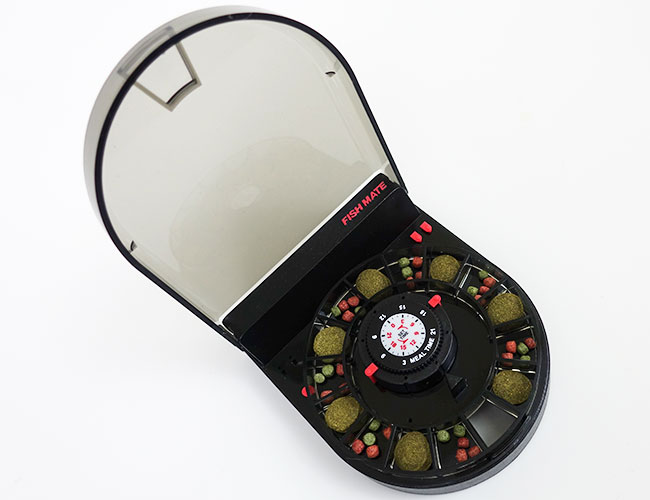
Tray-based feeders work more like a pill organizer. You preload each tray with a specific amount of food, and when it’s time to feed, one tray opens and releases its contents.
This style gives you total control over what your fish eat and when, but it requires more upfront preparation.
Pros
- You choose exactly how much food goes in each tray
- Great for mixed feeding (flakes + wafers + sinking pellets)
- Can schedule skip days or alternating feeds
- Better for large or odd-shaped foods
Cons
- Smaller capacity (usually 14 meals max)
- Needs refilling more often
- Setup is slower and more hands-on
Use A Tray Feeder If…
- You’re home often enough to refill weekly
- You feed multiple species with different food needs
- You want precise control over every meal
Not Sure Which To Pick? Start Here
| If You… | Use This Feeder Type |
|---|---|
| Travel often | Rotating barrel |
| Feed only pellets or flakes | Rotating barrel |
| Mix foods (like wafers and flakes) | Portion tray |
| Want skip days or alternate meals | Portion tray |
| Own a community tank | Portion tray (for accuracy) |
| Hate complicated setup | Rotating barrel |
Pro Tip: Some aquarists use both types. A barrel feeder handles daily pellet feeds, while a tray feeder drops in wafers or specialty foods a few times per week.
Weird Feeding Tricks That Actually Work
After testing 13 automatic fish feeders, we found that success isn’t just about which model you buy; it’s also about how you use it. A few minor adjustments can significantly improve the performance of your feeder.
Some of these came from trial and error. Others came from sheer frustration. All of them work surprisingly well.
The Tape Trick
If your feeder keeps dropping too much food, don’t rush to replace it. The fix might be a single piece of tape.
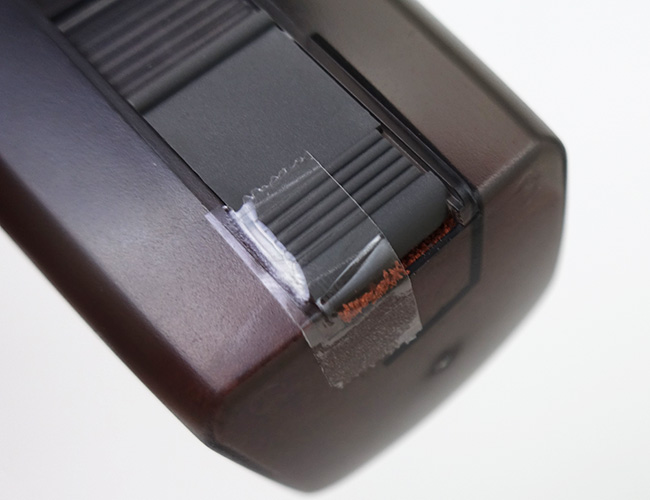
By placing a small strip of tape over part of the barrel opening, you reduce the amount of food that escapes each time it spins. With a bit of testing, you can adjust the placement to get consistent portions — even tiny pellet feeds for bettas or nano fish.
Tape Trick Setup
- Use clear tape or painter’s tape for easy adjustments.
- Cover one-third of the feeder opening.
- Run a few test feeds to dial in the right portion size.
This simple hack worked on nearly every rotating barrel feeder we tested. It costs nothing and solves one of the biggest problems owners face: overfeeding.
Crush Your Flakes
Fish flakes are unpredictable. Some are paper-thin, others the size of a coin, and that’s precisely why feeders struggle to dispense them evenly.

Lightly crushing your flakes before loading them makes portions much more consistent. Just pour them into a small bowl, crumble them by hand, and then fill the container.
Smaller pieces flow better and don’t get stuck in the feeder opening.
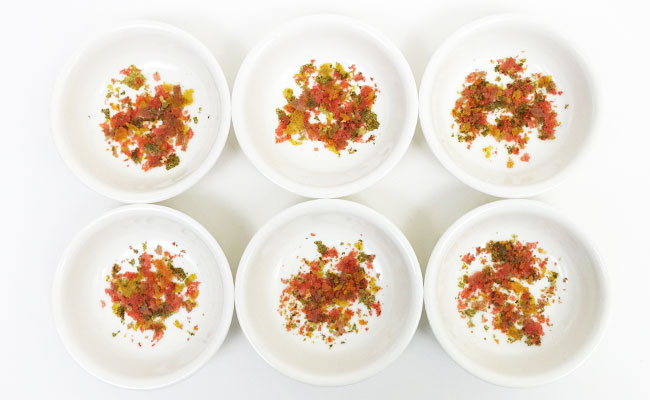
Pro Tip: If your feeder sits close to the waterline, crushed flakes also absorb less moisture than large ones.
Beat The Moisture Problem
Humidity and evaporation are the silent enemies of automatic feeders. Even a tiny bit of moisture can make food clump together and jam the dispenser.
To prevent this, keep your feeder away from strong filter outlets or bubbling air stones. If that’s not possible, try running an airline tube from your tank’s air pump into the feeder compartment (constant airflow helps keep food dry).
If you don’t want to deal with tubing, switching from flakes to pellets or granules instantly reduces moisture absorption.
Moisture Prevention Checklist
- Mount feeder away from bubbles or surface agitation.
- Use pellets instead of flakes in humid setups.
- Add airflow from an air pump if moisture persists.
Test Half-Full, Not Full
Here’s something we didn’t expect: most feeders actually perform better when they’re half full.

When completely filled, the extra weight compresses food inside the barrel, changing how much falls out with each rotation. A half-full container keeps portions consistent and prevents food from jamming near the edges.
Pro Tip: Refill mid-trip if possible, or pre-measure a half container before leaving. Your fish will thank you with clearer water.
Skip The Fancy Fans
Some feeders advertise built-in ventilation fans to prevent moisture buildup. After testing, we can confidently say: don’t pay extra for them.
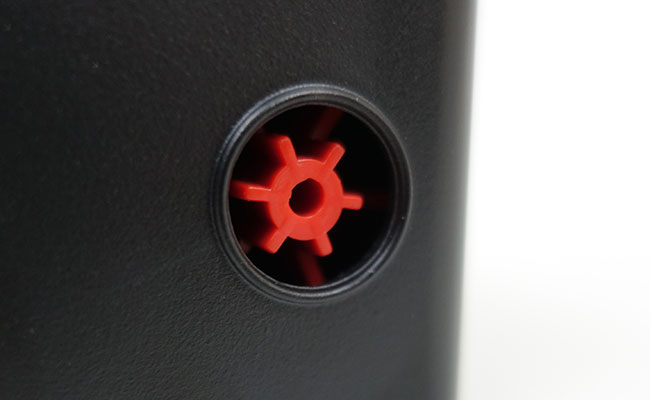
Those fans only run while the feeder rotates — about ten seconds total per day. They barely move air and don’t meaningfully reduce moisture. Positioning the feeder properly and using dry food will do more than any built-in fan.
Quick Takeaway: Good placement beats bad design every time.
The Double-Feeder Trick
For large community tanks, two feeders can outperform one. Use one for pellets or flakes and another for wafers or specialty foods. This method prevents jams from mixed food textures and keeps all species fed at once.
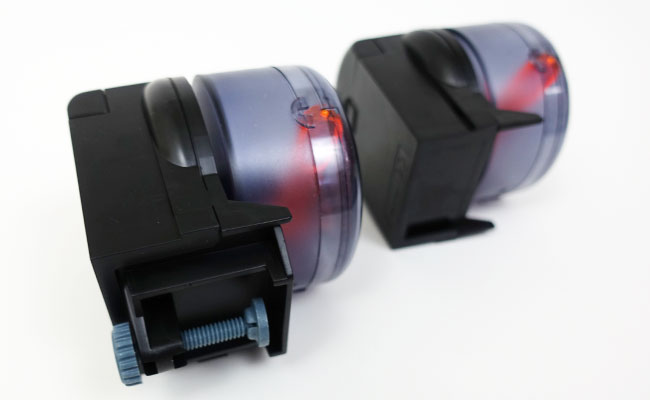
It might sound excessive, but it’s a reliable way to balance diets in tanks with bottom dwellers, surface feeders, and mid-level swimmers.
By combining these simple tricks — most of which cost nothing — you can turn even an average automatic feeder into a near-perfect system. Small adjustments make a big difference, and the payoff is clear water, calm fish, and zero feeding stress.
Frequently Asked Questions
Even after choosing the right feeder, small details can make or break your setup. These are the most frequently asked questions by aquarists when they begin using automatic feeders.
Don’t see your question? Ask us in the comments!
Can I Use An Automatic Fish Feeder For Frozen Food?
No, automatic feeders are designed only for dry food. Frozen food melts quickly, creating moisture that clogs the dispenser and ruins the motor. Even freeze-dried foods, while technically dry, can absorb humidity and stick together if not stored properly.
If your fish rely on frozen meals, you can still automate feeding by switching to high-quality freeze-dried or dehydrated versions of the same ingredients. Many brands now produce freeze-dried bloodworms, brine shrimp, and plankton that rehydrate easily when submerged in water. It’s not a perfect replacement, but it’s the safest option for automatic feeding.
How Often Should I Refill My Automatic Feeder?
Most feeders can hold anywhere from one to six weeks of food, depending on the tank size and feeding frequency. For best results, don’t fill the container to the top. A half-full barrel tends to dispense food more evenly, preventing the weight of packed pellets from jamming the mechanism.
Check your feeder at least once a week to confirm that food hasn’t absorbed moisture or clumped together. In humid conditions or saltwater setups, inspect even more often. Keeping portions small but consistent helps maintain water quality and prevents overfeeding.
Will My Fish Overeat With An Automatic Feeder?
They might if your feeder isn’t correctly calibrated. Overfeeding is one of the most common mistakes made by new users, especially with rotating barrel feeders. If too much food drops in at once, uneaten bits break down and raise ammonia levels in the tank.
Run several trial feeds before leaving your feeder unattended. Adjust the opening size and observe how quickly your fish finish eating.
The right portion should be gone within two to three minutes. Anything longer means you’re dispensing too much.
Can I Leave My Feeder Running While I’m Home?
Yes, and you should. Running the feeder daily while you’re around helps confirm that it’s dispensing consistent portions and keeps the motor in good working condition. Treat it like a long-term maintenance test.
Even if you prefer hand-feeding most of the time, letting the feeder run once a day for a week ensures it will work perfectly when you actually need it. Think of it as a safety drill for your fish.
What Kind Of Food Works Best In Automatic Feeders?
Pellets and granules are the most reliable. They flow evenly, resist moisture, and rarely jam. Flakes can work, but they’re more prone to clumping and inconsistent portion sizes unless you crush them into smaller pieces first.
Avoid oversized wafers, sticks, or bulky treats unless you’re using a tray-style feeder designed for large foods. Always test new food types with your feeder before leaving for vacation.
Do Feeders Work For Small Or Nano Tanks?
They can, but you’ll need to fine-tune the setup. Smaller tanks require smaller portions, which means even a slight overfeed can spike water quality. The tape trick from earlier in this guide is handy for nano setups.
If your fish are tiny or your tank is under ten gallons, use a micro-feeder designed for bettas or shrimp tanks. Always test feed portions and adjust carefully — small tanks react quickly to changes.
Can I Use Two Feeders On The Same Tank?
Yes. In fact, using two feeders can be a smart move for larger community tanks. One can handle pellets or flakes for your general population, while the other dispenses wafers or sinking foods for bottom dwellers.
This approach prevents food from mixing and clogging within a single device, while ensuring each species receives a fair share. Just ensure the feeders are positioned to drop food in separate areas of the tank, so one group doesn’t dominate every meal.
Feeding Made Simple
If you’re ready to take your aquarium feeding to the next level, check out these related guides:
Each one dives deeper into feeding efficiency, nutrition, and creative ways to simplify your care routine while keeping your fish happy and healthy.

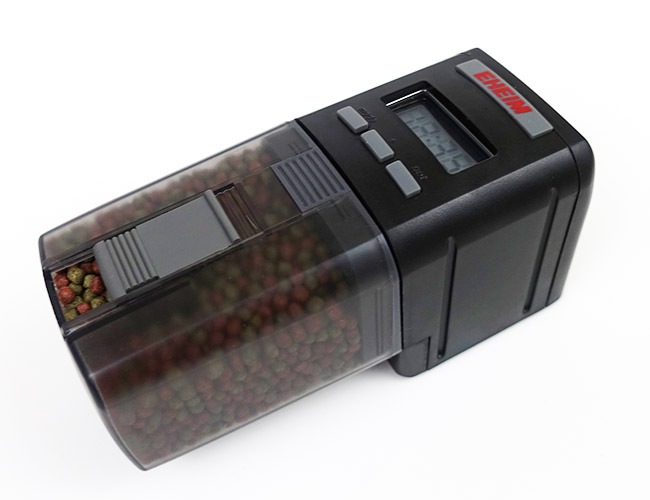
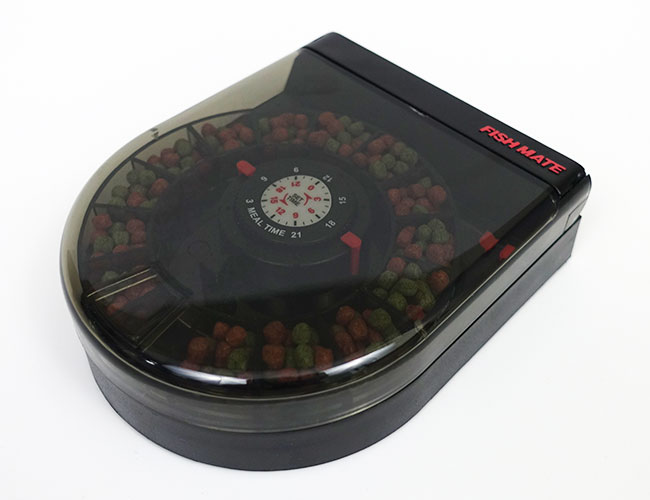
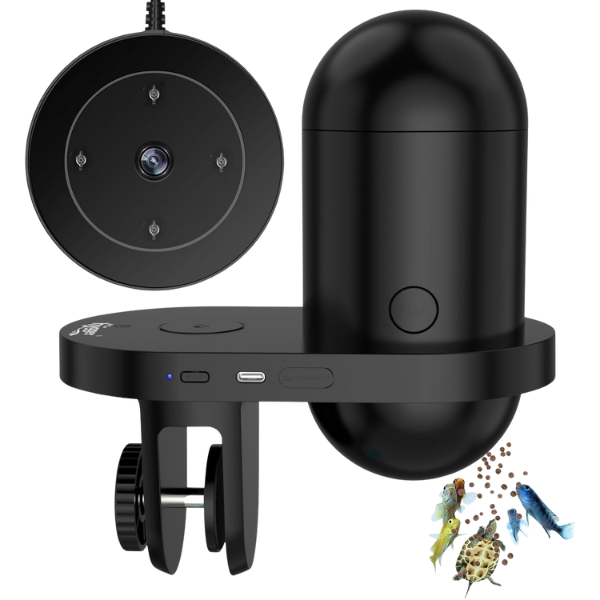
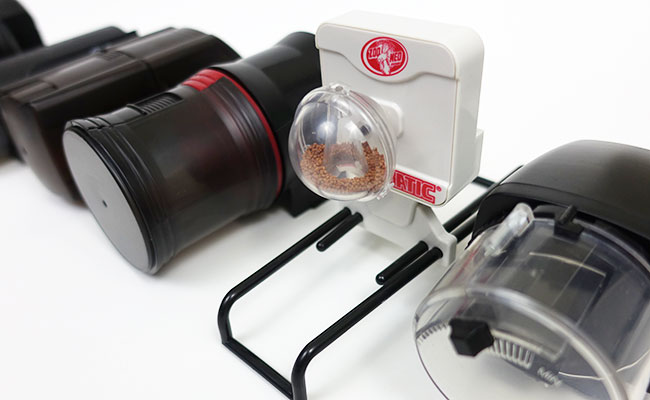



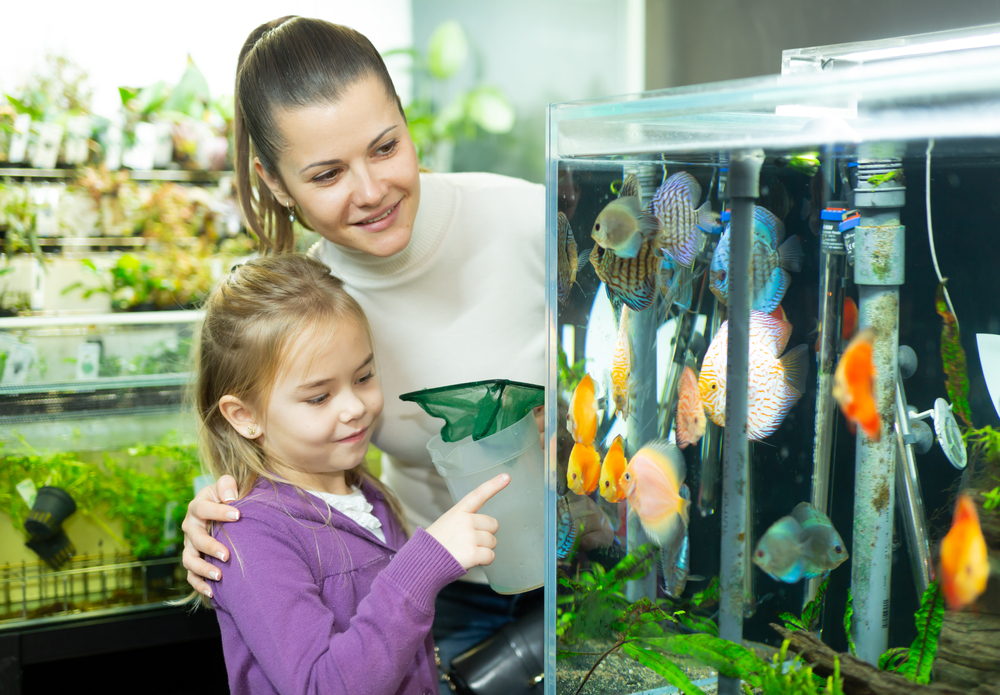
After 40 years of keeping tropical fish, I came to the same conclusions you did. This is unfortunate fo me, as I was looking for something that has more capacity than your top 2 choices, which I use every day for all of my tanks.
For those reading this blog, though, this is good news as it is truly spot-on in its findings. Tough to tell these days what is advertiser-driven and what is objective.
Hi Dr. X
Thanks for the awesome feedback. I’m glad to hear that our rigorous testing produced the same outcome as your real-world experience. I agree on the need for a higher capacity fish feeder, my preference would be in the Fishmate style – I love the precision it offers. Unfortunately, at the time of writing this, no consumer friendly solution exists. But should that change, we will definitely be updating this guide to test it!
So depressing to find the eiheim everyday fishfeeder in top.
For me they been nothing but trouble. The best one so far for me has been JBL Autofood, but they break, due to low quality build they just stop feeding, so they are far from reliable.
I guess I’ll have to build my own if I want something that really works :/
Hi J,
Thanks for your comment!
When properly set up, we found the Eheim fish feeder to be an incredibly reliable fish feeder.
I understand that each fish owner will have their own unique needs. So with that in mind, what issues did you have with the feeder?
I would love to compare the JBL Autofood, but it looks like this fish feeder is only available in Europe. Unfortunately, we only review products available on our home turf (United States.)
Based on our rigorous testing, We still stand behind our verdict that the Eheim fish feeder is best automatic fish feeder for most people.
I bought a Top Fin Automatic Feeder and it only lasted a week before it failed. It wouldn’t stop rotating and dumping food in my tank. I’m glad I was at home at the time or it would have killed my fish. I should have known better with how confusing the instructions were. Not only that but I paid more for it than your recommendation here. I wish I read this first.
Hi Rosalina,
I can’t say I have ever heard of that kind of malfunction before. That sounds like an awful experience. I hope it doesn’t scare you off automatic fish feeders for good.
If you do want to try again, I am confident you will have a better experience with the top picks listed in this guide.
Just a tip.
I read in another review that some fish feeders will exhibit this behavior if the batteries are inserted the wrong way round. The drum can’t “home” as the electronics are not working, so it continues to rotate round and round.
Hi Jeffo,
That’s very interesting, thanks for sharing this!
Frustrated! I keep trying to use my fish feeder with flakes and they keep clumping together. Fish feeders don’t work.
Hi Leha,
If you have moisture issues, the first thing you should do is stop water splashing or spraying your fish feeder. If you sit your feeder near your filter outlet, airstone, or any other water movement device. While it might not look like it, really tiny splashes of water may be spraying your feeder, causing your flakes to go soggy.
Next, I suggest swapping over to pellets. Flaked foods absorb moisture quickly, which causes them to stick together. When this happens, good luck getting them to come out of your fish feeder. Pellets do not absorb moisture as easily, allowing them to be easily dispensed. If you are still having trouble, you might not be going through the feeder container fast enough. Try filling up the container so that it’s only a half or quarter full.
Automatic fish feeders do work. You’ll get the hang of it!
I have been using the eheim fish feeder since it used to be called the feedair all those years ago. Still the same product. Surprised nothing has come along thats better.
Hi William,
Well, while not much else may have changed, at least Eheim did change the name. To me, ‘Feedair’ is a pretty bad name for a product. I think the Eheim fish feeder is a great example of ‘if it ain’t broke, don’t fix it.’
What about Grasslin automatic fish feeder? Is it any good?
Hi Jimmy,
I would have loved to have tested the Grasslin, it actually came up while we were deciding which automatic fish feeders to test. However, we had to pass it up given that it is not readily available on our home turf (United States.) In order to ship this over it would cost over $65 USD and that doesn’t even include shipping. At this price you could by any of our top two picks three times over.
If Grasslin ever releases their automatic fish feeder in America, we will update this guide to include it!
Amen for eheim auto fish feeder. If you buy anything else it will break and you will end up buying the eheim anyway.
Hi George,
Thanks for your feedback. Glad to hear you are enjoying our recommendation!
I tried several before ending up with a grasslin – it has 27 compartments so will keep going for 2 weeks with 2 feedings a day or almost a month with a single feeding. I found that it doesnt really work so well with the protecting lid on as moisture gets captured and will make the food stick to the little trays and wont fall out so easy. But with the lid removed it works great and will dispense the right mix of food everytime. It can be set to feed from 1 – 4 times a day (im doing twice). I have had it for about a year and would certainly recommend. Only wish it would come in more sizes. Mine just sits on top of the aquarium lid so i wouldnt mind if it was a lot bigger (with more compartments) but since its rare that im gone for more than 2 weeks, this is my perfect choice
Hi Tom,
Thank you so much for sharing your experience. You are actually the second person here to suggest using a Grasslin automatic fish feeder. Unfortunately for us here in the United States, it’s not a product that is readily available. The closest thing we have is the F14 fish feeder, which is still pretty great. If the Grasslin fish feeder is ever released here I will be sure to test it and compare it to my top recommendations in this review.
Thank you very much for this article. I have a beautiful Betta in a cycled and heated 5 gallon tank. I now have to travel for work twice a month – 5 days at a time – and I wasn’t sure how to keep him fed without moving the tank to a friend’s house. Your suggestion for using Eheim feeder is excellent! Now I just hope my little guy doesn’t get lonely.
Thanks again for the terrific and informative review.
Hi Carla,
Your betta may also be able to survive without food for 5 days just fine – especially if everything else in your tank is perfectly healthy (parameters, cleaning schedule etc.) Many betta will happily last this long without food (they often woldn’t eat every day in the wild) Why not trial your fish at home not feeding for 5 days to see if that works – this way you won’t have to worry about buying an automated fish feeder.
I came upon this article just today so hope it’s not too late for a comment. First off, very thorough and well done.
I’ve used the Eheim feeders for many years. Quite a few of t hem have gone “swimming” when I accidentally knocked them in the tanks so I restricted myself to using them only while I’m traveling. For various reasons I haven’t found a mounting process that works in some of my situations.
Anyway, I’m curious as to which feeder will retain the settings even if/when you remove the batteries? That’s the one thing I really want but haven’t found.
Hi Mickey,
Thanks for the kind words!
Unfortunately, that’s a risk with all automated fish feeders. It’s why I recommend buying a big chunk of Velcro with a sticky back and covering the base with it – that fish feeder won’t go far in a hurry. Unfortunately, this only works if you set the feeder on a flat surface. One of the guys from my local aquarium club has a big piece of wood that is the same height as his aquarium, sitting next to it, with his automatic fish feeder attached permanently – that’s an option if you don’t have a lid?
Eheim feeders are one of the only ones I tested that can retain their settings when you remove the batteries. The trick is to be quick. You have about 10 seconds to swap the batteries out, after this, it will lose it’s setting. I suggest practicing this a few times in preperation, you’ll soon get the hang of it!
Dear FishLab, I agree with your opinion on EHEIM’s superior quality. However, I have a question on the integrated fan and ventilation system. EHEIM Everyday Fish Feeder’s fan and ventilation system vs. DoPhin AF013’s one, would you tell me the real comparison? Thank you.
Hi Kisoo,
Fans shouldn’t be the differentiator as they are not strong enough to dry food in a moist environment, they might as well not be there. If moisture is a concern, Check out a sealed unit or one that hooks up to an airpump to blow air over the food continuously.
Thank you, sir. I admit that the auto feeders are not able to everything. I bravely 🙂 decide to use the DoPhin AF013 and I will tell you if I find further pros and cons.
Hi Kisoo,
They certainly can’t. Unfortunately, these features are added to make a product look better than the competition rather than be of practical use to the consumer. I will be very interested to hear your thoughts.
Is there any that’ll let you schedule an “every other day” or “every couple of days” routine? I’ve been trying to find a feeder suited for my aquatic turtles feeding schedule.
Hi Nick,
You can use the fishmate feeder. Just fill every second container, leaving the ones inbetween empty. This way, as it rotates, it will only feed on the second day.
Hi, I bought an auto fish feeder that has 4 modes of feeding
1 x day
2 x day
1 x 48 hrs
1 x 72 hrs
but it doesnt have a clock, so how do I know exactly what time it feeds my fish? the model is warm tone wt-688.
Hi Alex,
You’ll have to read the instructions for this one. They all operate slightly differently. If it doesn’t have a clock, then it could be from the time you set it, but that’s just guessing. I have never heard of the brand “warm tone” – you might have to take it for a test run and see when and how often it turns.
Hi Ian, thanks for your reply. The warm tone brand is from china so maybe that is why you haven’t heard of it. I have read the instructions, but it doesn’t say anything about what time it dispenses. It looks like it was originally written in chinese and was translated to english and not properly. I’m hoping you are right about the time when i set it. I’m going to have to wait 24 hrs to see if it really works.
Can you please recommend me a fish feeder? I have a really small tank that has a lid, and i want the lid to still be able to close if i attach a fish feeder.
That explains it. It feels like every week there is a new chinese brand of fish feeder on the market. It’s hard to keep up. It’s Unfortunately, it’s just the waiting game for you now. I hope it works as expected. Outside of the top three I listed in this article, I don’t really recommend any others.
Hi,
Great article, thank you!
We haven’t had an aquarium in years when my daughter came home from the State Fair with a goldfish in a bag. This was last year and at that point, we just gave away all our old setup. Since it was a fair fish and I was not expecting more than a few months (if that) I ran with her to the store and got her a 5 gallon tank. Well the fish is about to celebrate his 1st birthday and we find ourselves having to go away for a few days. I know I can go without feeding him but I feel bad about doing that and my daughter won’t let me so I am looking at options. Since it is only a 5 gallon tank, I do not want anything too big. He only eats a few flakes once per day.
What would be the best option in this situation?
Thank you!
Hi Aimee,
Any rotating barrel feeder is likely going to overfeed to the point of problems in a 5 gallon tank. The only real solution would be to swap over to pellets and individually measure each amount out into a container in the Fishmate f14 feeder. Even so, like you have rightly pointed out, it’s not an ideal solution.
Thank you, that is what I was afraid of. Would the Fish Mate not work with flakes or just difficult to make it work properly?
I am thinking I might have to ask a neighbor to stop in once a day. Thanks!
For a pinch of flakes, you’ll find that they slide under the rotating container walls and get stuck. When this happens, none or not enough food will get dispensed. Pellets are slightly larger and should have no problem being pushed as the container rotates.
Hi
I am going on vacation for a month. I keep tropical fish in a 200 litre tank and usually use tropical flake food.
What automatic fish tank feeder would you recommend bearing it must have enough storage capacity to last for a month
Thank you
Terry
Hi Terry,
It would depend on your fish and the type of food used but my top recommendation in this article would still be my suggestion.
Hi Ian, thanks for the review.
As we know, fish food will changes over time as it is exposed to air, heat and light, that is why we keep them in sealed plastic/container. But many auto feeder like Eheim Everyday Fish Feeder has an adjustable opening in their container that will continuously exposed the food to the air, won’t this degrade the food quality?
Hi Agus,
You are correct in that air will lead to a decline in the quality, but automatic fish feeders are typically only used short term, when you are away from your fish. When you are at home, you would feed your fish as normal. For occasional use, it’s less of an issue.
Hi Ian,
This is a very in-depth analysis of various fish feeders, so I’m sure you have done quite a bit of research.
I was wondering if there are any other fish feeders that would allow you to dispense exactly the amount of feed you want per serving, like the fish mate would. I have found the Grässlin rondomatic 400 which seems to be able to do this, but looks to be quite expensive. I don’t need a fish feeder with an enormous capacity though, just being able to serve 6 meals automatically before needing a refill would already be enough. The only problem is that they have to be measured exactly.
Unfortunately, I can’t use the Fish mate due to its very slow release of feed, which causes the more dominant fish to eat all the feed before the smaller ones. I only use granular food for small cyprinid fish.
Is there any other feeder you could recommend?
Thank you for your time!
Hi Rik,
The Rondomatic is somewhat of a rarity in America. While you can get it through specialist fish stores, it can be difficult to track down, so I didn’t include it in the round-up. Unfortunately, you would likely have the same issue with it slowly releasing food. This is the way all circular fish feeders with compartments seem to operate. These are the only fishfeeders I know of that dispense pre-measured amounts. The only solution I see is gluing something to the wall of each compartment, reducing it’s size, causing the food to stack. This way, when the section opens up, it all tumbles into the tank at once